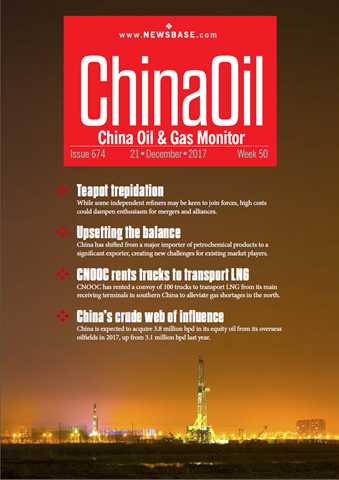Discuss your challenges with our solutions experts
Is the outlook for China's petrochemicals market hanging in the balance?
We posed 8 questions to Steve Jenkins, Vice President Consulting - Chemicals, Polymers & Fibres about China's petrochemicals market
1 minute read
Steve Jenkins
Vice President, Chemicals Consulting

Steve Jenkins
Vice President, Chemicals Consulting
Steve brings more than 30 years experience in chemical markets, and is a world expert in paraxylene.
Latest articles by Steve
-
Opinion
No silos allowed in the pursuit of a greener economy
-
Opinion
Is the outlook for China's petrochemicals market hanging in the balance?
-
Editorial
Is the outlook for China’s petrochemicals market hanging in the balance?
-
Editorial
PTT re-engages in South East Asia with new chemicals investments
-
Editorial
ExxonMobil acquires Southeast Asia’s Jurong Aromatics
-
Opinion
ExxonMobil acquires Southeast Asia's Jurong Aromatics
1. Is China likely to generate half of all global incremental growth in petrochemicals between now and 2025?
China is the de facto growth market for petrochemicals in the coming 10 years. In terms of its sheer scale there are no other countries that come close. It is the world's second largest economy with a nominal GDP for 2017 estimated at $11.8 trillion, second to the US, but is comfortably the largest in terms of GDP on a purchasing parity base at over $23 trillion.
2. How is China's government reacting to a more consumer-driven economy?
GDP per capita in nominal terms is only $8,480, indicating that there remains huge domestic potential for consumption, something which China's government recognises as it tries to rebalance its economy away from the last 20 years of capital intensive investment to a more consumer-driven economy.
3. Are there similarities with India's petrochemical landscape?
Despite having a comparable population, India is an order of magnitude smaller in its chemicals demand and has a different political and economic structure that has not yet delivered the growth seen in China. The concentration of manufacturing in China and its export focus are key growth drivers for basic petrochemicals such as ethylene, propylene, paraxylene and benzene, as well as derivatives of these major product groups.
The term of China demand growth "slowing" tends to be overused and does not properly represent the market. Demand continues to grow and despite percentage growth rates not being as high as history the sheer volumes are quite healthy. Therefore, on a volume basis "slowing" is not apparent.
Private enterprises are now being given more latitude to invest, as state-owned enterprises take a back seat after decades of planned growth. Licenses to import feedstock have been granted and the process of liberalisation, supported by accommodative financing, has encouraged expansions across many chemical sectors. Whether the dash for domestic market share by local producers is justified has been an issue for a non-China chemical industry that has invested to supply China's explosive growth in the past 15 years.
What is clear is that many of China's private industrial companies have reached a critical mass in terms of chemicals consumption and look to match overseas success stories, such as India's Reliance Industries, which have grown from small scale local enterprises to world scale chemical producers in the space of 20-30 years. Backward integration along various value chains, whether olefins or aromatics are now spawning mega-petrochemical complexes that are likely to reverse decades of import trade flows.
4. What will help to alleviate the overcapacity in the country's styrene markets?
The mega-size aromatics complexes are the top down drivers of many derivative expansions in aromatics value chain, specifically styrene and phenol/BPA/polycarbonate/epoxy resins.
Despite relatively high self-sufficiency in styrenic polymers (PS/EPS/ABS), China will capture about 60% of the world's incremental styrene demand by 2025 to feed the derivative plants, owing to the domestic demand growth, which will also help to alleviate the overcapacity in the country's styrene derivatives and polymer markets. New investments in polycarbonate will drive China's phenol demand growth over the coming years as the demand into this segment will be tripled by 2025.
5. Won't something have to give?
The high-speed demand growth in China will be at the expense of declining exports from the existing overseas producers, even though some majors such as Sabic and Covestro have taken proactive movement by increasing their investment in China.
In the polyester chain for example, China dominates global polyester fibre production and has a major position in the production of PET for packaging. Between 2017 and 2025, PCI Wood Mackenzie is forecasting that China captures 59% of global paraxylene consumption growth, equating to 10 million tonnes out of a forecast 17 million tonnes global growth.
6. So why does China's chemicals industry remain unbalanced?
It's true, despite such impressive growth figures China's chemicals industry does remain unbalanced, with several key global commodities remaining key import products. Lack of competitive feedstock supplies (China's olefins industry cannot compete with low-cost ethylene from US ethane for instance) can be structural barriers to faster domestic investment. In aromatics, the country's benzene trade deficit will remain and even increase in the next 5-7 years with China remaining the biggest global importer due to growth of benzene derivatives. With no on-purpose methods to produce the benzene feedstock, China's domestic supply struggles to keep up with the growing demand into derivatives such as styrene, phenol and aniline.
7. China appears to be most deficient in ethylene. Is this likely to remain so, especially with China set to ban imports of plastic waste from 2018?
Between 2017 and 2025, we expect China's ethylene and propylene capacities to increase by over 70% (over 40 million tonnes of ethylene and propylene capacity growth). For PE and PP, about 60% capacity growth from 2017-2025 (which equates to over 25 million tonnes PE and PP capacity increase). However, we expect China to remain deficient in ethylene and primary derivatives through our forecast period out to 2035, despite large investments. This is in stark contrast to propylene and polypropylene, in which China attains self-sufficiency on a capacity basis this year, largely due to ongoing investments in PDH/CTO and MTO plants. Excess availability and exports of propane from the USA have allowed these PDH investments.
The ban on plastic imports intuitively should lead to a step increase in virgin resin demand which in turn increases both ethylene demand and PX/PTA demand for polyesters.
8. With petrochemical plant development showing no sign of slowing, will China be in a position by 2025 to export by 2025?
China has already been exporting PTA for several years, after a decade of being the world's largest importer, moving from almost 7 million tonnes of PTA imports in 2010 to a forecast exporter of 1.5 million tonnes by 2025. PET export volumes after years of extensive capacity additions has catapulted China into a large export position. China has also been exporting PE/PP, though the volume remains small relative to their import position. We expect China's net import position of PE to grow, while that of PP to gradually fall, as China increases its self-sufficiency in PP. In terms of threat to their traditional trade partners, it will be more apparent in the propylene chain than in the ethylene chain with polypropylene imports falling and more cost competitive polyethylene holding a structural advantage for North American and Middle East exporters. For aromatics producers, especially those in Asia and the Middle East, the battleground may well be gasoline rather than aromatics per se as China's refiners ramp up production to meet a growing domestic market and traditional refiners begin to face slowing fuel demand growth, with a corresponding need to re-invent themselves. Aromatics competitiveness and opportunities may be unique to individual refineries. There is still a lot of work to be done to really understand what the future may hold.







